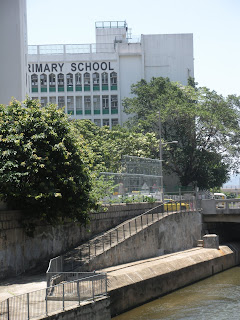
 The Kaitak River has a high number of schools along it because it was considered a "dis-amenity." These schools are becoming involved with restoring the waterway. One is even willing to move to a different place in order to open up the waterway even more to the public.
The Kaitak River has a high number of schools along it because it was considered a "dis-amenity." These schools are becoming involved with restoring the waterway. One is even willing to move to a different place in order to open up the waterway even more to the public.
 One of the local battles taken on was over this high rise that was located close to the Kaitak River, closing off the view. As a result it of the intervention of the local group, one corner was moved back and it will also have a display about the river in the facility.
One of the local battles taken on was over this high rise that was located close to the Kaitak River, closing off the view. As a result it of the intervention of the local group, one corner was moved back and it will also have a display about the river in the facility.


 One of the important culture features that the Katiak River group is trying to maintain is the Ngan Tsin Wai village. It is one of the few old villages left within the city but is threatened with development. It is right along the river--the entrance is amongst the flags above.
One of the important culture features that the Katiak River group is trying to maintain is the Ngan Tsin Wai village. It is one of the few old villages left within the city but is threatened with development. It is right along the river--the entrance is amongst the flags above.



I went on a fieldtrip with a group of public administration graduate students from USC to the Kaitak region of Kowloon. Kaitak was the name of the old airport that closed around 13 years ago. The are of the city remained low rise because of the flight path and now development pressures are increasing. A Chinese University of HK Professor of Architecture, Wallace, Chang, has been working with locals on trying to shape the form of development. Part of that effort has been focused on bringing attention to a waterway that has been named the Kaitak River and using it as a focus for community-engaged planning. This entire effort reminds me much of the Plaster Creek efforts in Grand Rapids. Ironically, the Kaitak River has water because it is pumped over the mountain in the New Territories from the water treatment plant into the Kaitak River. The water cannot go into the bay on the north side of the mountains because there is now enough current to pull the water out into the ocean, so it would lead to a build-up of pollution. But this water actually improves the water quality on the south side of the mountains!
For more on this effort: hk.myblog.yahoo.com/kaitakriver




No comments:
Post a Comment